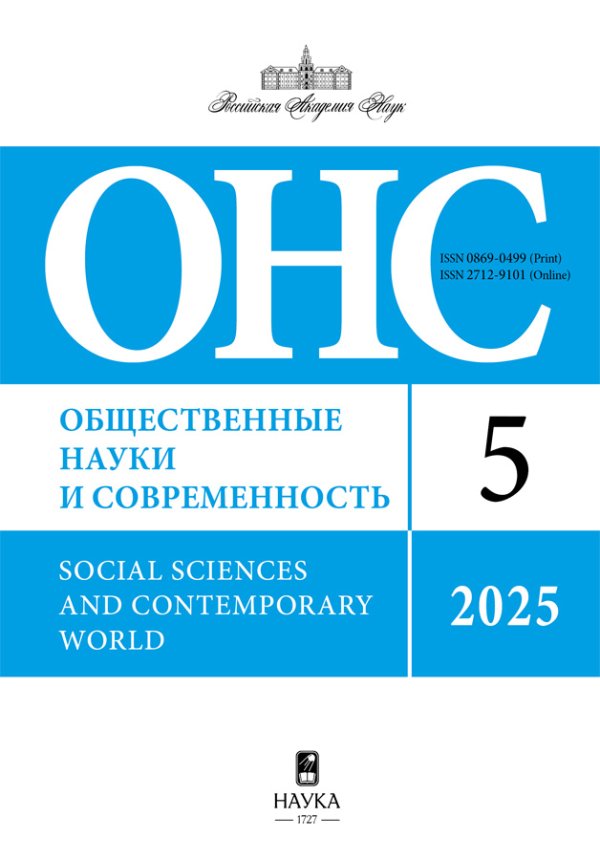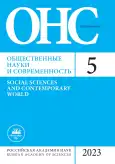Destabilization of the old world order and the formation of a new world order: main trends and alternatives
- Authors: Pantin V.I.1, Lapkin V.V.1
-
Affiliations:
- Primakov National Research Institute of World Economy and International Relations
- Issue: No 5 (2023)
- Pages: 7-18
- Section: Articles
- URL: https://journals.rcsi.science/0869-0499/article/view/249605
- DOI: https://doi.org/10.31857/S0869049923050015
- EDN: https://elibrary.ru/NHXKNY
- ID: 249605
Cite item
Full Text
Abstract
About the authors
Vladimir I. Pantin
Primakov National Research Institute of World Economy and International Relations
Email: v.pantin@mail.ru
Москва, Россия
Vladimir V. Lapkin
Primakov National Research Institute of World Economy and International Relations
Email: vvlh@politstudies.ru
Москва, Россия
References
- Барановский В.Г. (2017) Трансформация глобального миропорядка: динамика системных изменений // Полис. Политические исследования. № 3. С. 71-91. doi: 10.17976/jpps/2017.03.05
- Бубнова Н.И. (2022) Тотальные санкции Запада против России в контексте "интегрированного сдерживания" // Общественные науки и современность. № 6. С. 7-22. doi: 10.31857/S0869049922060016
- Глазьев С.Ю. (2018) Рывок в будущее. Россия в новых технологическом и мирохозяйственном укладах. М.: Книжный мир. 768 с.
- Гринин Л.Е., Коротаев А.В., Цирель С.В. (2011) Циклы развития современной Мир-Системы. М.: ЛИБРОКОМ. 248 с.
- Делягин М.Г. (2003) Мировой кризис: Общая теория глобализации. М.: ИНФРА-М. 768 с.
- Караганов С. (2022) От конструктивного разрушения к собиранию // Россия в глобальной политике. Т. 20. № 2. С. 52-69.
- Кокошин А.А., Панов А.Н. (2014) Макроструктурные изменения в системе мировой политики до 2030 года. М.: КРАСАНД: URSS. 328 с.
- Комаров И.Д., Горбунова М.Л. (2022) Трансформация мирового порядка через призму культурных измерений Г. Хофстеде // Контуры глобальных трансформаций: политика, экономика, право. Т. 15. № 5. С. 6-28. doi: 10.31249/kgt/2022.05.01
- Кондратьев Н.Д. (1925) Большие циклы конъюнктуры // Вопросы конъюнктуры. Т. 1. № 1. С. 28-79.
- Кортунов А.В. (2020) Кризис миропорядка и будущее глобализации. Доклад РСМД. М.: НП РСМД. 60 с.
- Мюллерсон Р. (2022) От падения Берлинской стены до возведения новых ограждений // Россия в глобальной политике. Т. 20. № 2. С. 34-51.
- Пантин В.И., Лапкин В.В. (2006) Философия исторического прогнозирования: ритмы истории и перспективы мирового развития в первой половине XXI века. Дубна: Феникс+. 448 с.
- Пантин В.И., Лапкин В.В. (2014) Историческое прогнозирование в XXI веке: Циклы Кондратьева, эволюционные циклы и перспективы мирового развития. Дубна: Феникс+. 456 с.
- Acharya A. (2014) The End of American World Order. Cambridge: Polity Press. 150 p.
- Akaev A., Pantin V. (2014) Technological Innovations and Future Shifts in International Politics // International Studies Quarterly. Vol. 58. No. 4. Pp. 867-872.
- Arrighi G. (1994) The Long Twentieth Century: Money, Power and the Origins of Our Times. London, New York: Verso. 416 p.
- Arrighi G. (2007) Adam Smith in Beijing: Lineages of the Twenty-First Century. London, New York: Verso. 418 p.
- Colgan J.D., Keohane R.O. (2017) The Liberal Order is Rigged: Fix It Now or Watch It Wither // -Foreign Affairs. Vol. 96. No. 3. Pp. 36-44.
- Duncombe C., Dunne T. (2018) After Liberal World Order // International Affairs. Vol. 94. No. 1. Pp. 25-42.
- Ferguson N. (2014) The Great Degeneration: How Institutions Decay and Economies Die. London: Penguin Books. 174 p.
- Frank A.G. (1998) ReORIENT: Global Economy in the Asian Age. Berkeley, CA: University of California Press. 416 p.
- Hirooka M. (2006) Innovation Dynamism and Economic Growth. A Nonlinear Perspective. Cheltenham: Edward Elgar Publishing. 448 p.
- Huntington S.P. (1996) The Clash of Civilizations and the Remaking of World Order. New York: Simon & Schuster. 368 p.
- Ikenberry G.C. (2018) The End of Liberal International Order? // International Affairs. Vol. 94. No. 1. Pp. 7-23.
- Kennedy P. (1989) The Rise and Fall of the Great Powers: Economic Change and Military Conflict from 1500 to 2000. London: Vinter Books. 704 p.
- Kissinger H. (2014) World Order. New York: Penguin Books. 432 p.
- Korotayev A., Meshcherina K., Shishkina A. (2018) A Wave of Global Sociopolitical Destabilization of the 2010s: A Quantitative Analysis // Democracy and Security. Vol. 14. No. 4. Pp. 331-357.
- Modelski G., Thompson W.R. (1996) Leading Sectors and World Powers: The Coevolution of Global Economics and Politics (Studies in International Relations). Columbia, SC: University of South California Press. 282 p.
- Piketty Th. (2014) Capital in the Twenty-First Century. Cambridge, Ms. and London: Harvard University Press. 685 p.
- Turchin P. (2013) Modeling Social Pressures toward Political Instability // Cliodynamics: The Journal of Quantitative History and Cultural Evolution. Vol. 4. No. 2. Pp. 241-280.
- Jan van Dijk (2020) The Digital Divide. Cambridge, Medford: Polity Press. 208 p.
- Zakaria F. (2008) The Post-American World. New York, London: W.W. Norton & Company. 292 p.
Supplementary files










